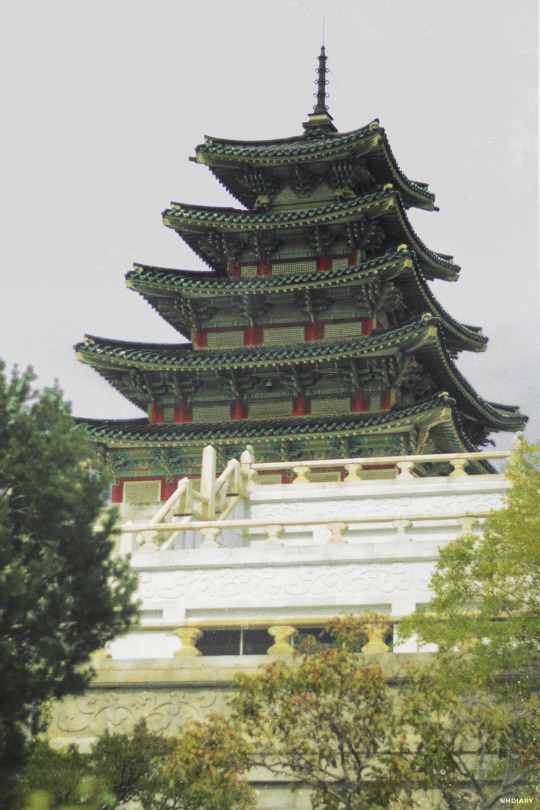#National Folk Museum of Korea
Text
2023 World Day for Audiovisual Heritage in Korea.
The Korean Association of Audiovisual Preservation (KAAP) and the Institute of Information and Archival Science in Hankuk University of Foreign Studies are going to organize a screening of the feature film <Let's Meet at Walkerhill (Wokeohileseo Mannapsida>(1966) and a special talk session on Hallyu and Korean culture curation.

In the classic film < Let's Meet at Walkerhill> (1966), directed by Han Hyung-mo, a Korean music movie that allows you to understand the prototype of movies and popular songs that are a big part of the so-called "Korean Wave" and the popular culture of the 1960s. In the 1960s popular music landscape of South Korea, various genres were tried, including standard pop, rock, and folk songs, in addition to trot, foreign-style music, etc. You can meet these in the film. The Walkerhill Hotel was built in 1963 for foreigners, including American soldiers in South Korea. At the time, the Walkerhill Show was a venue for high-end shows with a sophisticated revolving stage. However, in order to showcase a wide variety of music and shows, popular music shows were held in various locations such as KBS TV show studio, music hall in Myeongdong, where young people used to go, and the hotel nightclub. For more information of the film, please refer to the film information in KMDB.
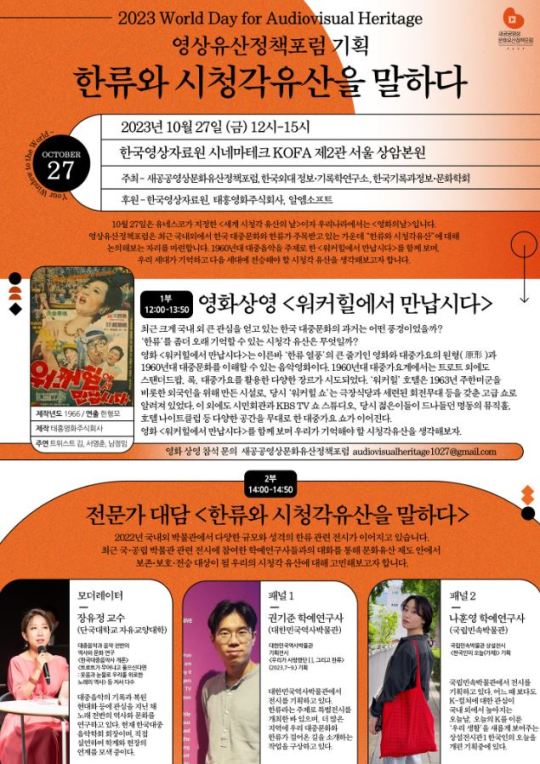
After the screening, a special talk on Hallyu (Korean Wave) and Audiovisual Heritage will be followed. Since 2022, Korean Wave-related exhibitions have been held in Korea and abroad. In September 2022, the Victoria & Albert Museum in the United Kingdom opened the "Hallyu! The Korean Wave" exhibition, and other national and public museums in Korea are also planning related exhibitions.
In this event, we will meet two young curators working in National Museums in South Korea will be speaking about their own experiences. through conversations with the curators who participated in the process of curation, we would like to consider the audiovisual cultural heritage that should be preserved, protected, and transmitted within the cultural heritage system. We expect main issues and its future directions on the preservation and public uses of Hallyu related items as audiovisual heritage in South Korea.
Moderator: Eujeong Zhang / (Professor, Dankook University)
Panels: Gi-Jun, Kwon (Curator, National Museum of Korean Contemporary History)
Hunyoung Na (Curator, National Folk Museum of Korea)
The Korean Association of Audiovisual Preservation (KAAP)
2023 World Day for Audiovisual Heritage in Korea.
27 October 2023
Korean Film Archive, 400, WorldCupbuk-ro, Mapo-gu, Seoul, 03925 Korea; Seoul - South Korea
#National Folk Museum of Korea#National Museum of Korean Contemporary History#Korean Association of Audiovisual Preservation#KAAP#korean film archive#korea#world audiovisual heritage day#27 october
0 notes
Text
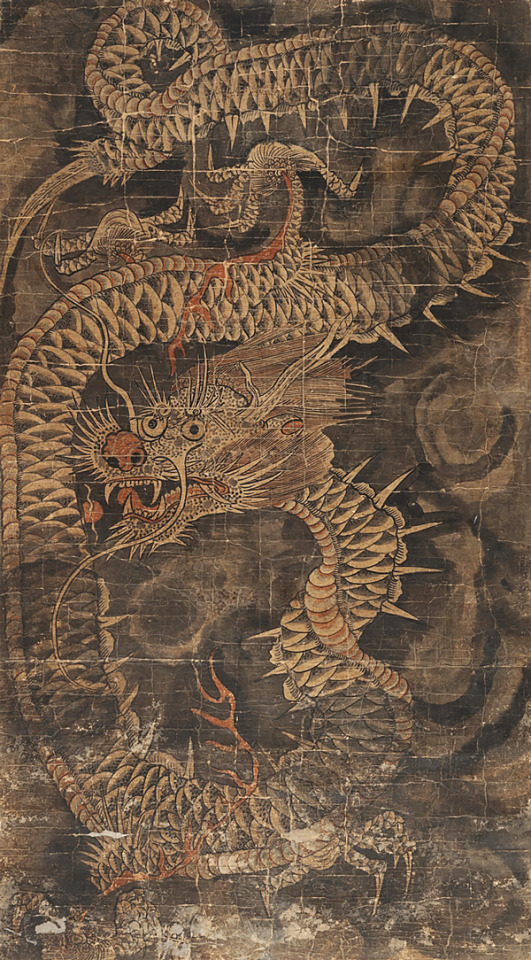
Happy Year of the Dragon
l 운룡도 Dragon in Clouds l Joseon l 19th Century l National Folk Museum of Korea
#year of the dragon#happy new year#2024#paintings#art#national folk museum#korea#new year's day#korean#19th century#joseon dynasty#south korea#seoul#lunar new year#dragon#blue dragon
676 notes
·
View notes
Text

Why These Imperfect Korean ‘Moon Jars’ Sell for Millions
Old, round, imperfect and beautiful — that’s how fans of Korean art describe the moon jar, or “dalhangari.”
These unassuming, plain white pots have entranced everyone from rapper RM, of K-pop sensation BTS, to philosopher Alain de Botton.
The former director of London’s Victoria and Albert Museum, Beth McKillop, has called the moon jar an “icon of Korean identity.” And if price is any indicator of popularity, one recently sold for over $4.5 million at a Christie’s auction.
This month, a rare example from the late 17th or early 18th century will go on sale at Sotheby’s in New York, where it’s expected to fetch more than $3 million.
“A large moon jar has always been expensive, but I think the big uptick in prices and value is… because their appeal is now global,” said Angela McAteer, Sotheby’s international head of Chinese art for the Americas and Europe, over video call. “You’ve got an international cohort of bidders competing for them, so it’s gone beyond the traditional connoisseur collecting community of Korean art.”

Huge price tags also result from the jars’ rarity. Although made for over a century in the royal kilns of Korea’s last kingdom, the Joseon dynasty, few are thought to exist today. Estimates for the number of larger ones (those more than 40 centimeters, or 15.7 inches, tall and wide) that have survived over the years range from 12 to 30.
Having passed through auction houses and antique dealers across the world, several of these are now in the collections of institutions like the British Museum and Boston’s Museum of Fine Arts, as well as in the hands of private collectors.
‘Owning a piece of happiness’
The first moon jars were created in the royal kilns in Gwangju (a city just outside Seoul, not the larger southern city of the same name) from 1650 to 1750. They were made from pure white porcelain and kaolin clay, and, following the neo-Confucian fashions of their day, the pots reflected values such as propriety, humility, frugality and purity. They were likely used at court and in upper-class homes as containers for food and liquids, or as decorative vessels.
In the mid-20th century, moon jars began gaining international appreciation thanks to influential admirers such as Japanese folk crafts scholar Yanagi Soetsu and British potter Bernard Leach, who bought one from a Seoul antique store in 1935. Leach once said that having a moon jar was like “owning a piece of happiness,” and would later give his to fellow potter Lucie Rie for safekeeping during World War II. It stayed in her studio until her death and was later acquired by the British Museum.
Charlotte Horlyck, lecturer in Korean Art History at the University of London’s School of Oriental and African Studies, wrote in the Art Bulletin journal that after World War II the moon jar “caught the attention of an early generation of postcolonial Korean artists and scholars who sought to restore Korean art history and national identity,” as the pieces “resonated with the visual language of international modernism and minimalism of the mid-20th century while remaining a distinctly Korean work of art.”
The moon jar’s allure
When Sotheby’s announced its forthcoming sale, the auction house described its 44-centimeter (17.3-inch) moon jar as an object that inspired, astounded and soothed those who “stand in its presence.” It’s a funny thing to say about a pot, to speak as if it’s alive, but the jars’ visceral, emotional impact on people is something that comes up time and time again in the literature.

Choi Sunu, a former director of the National Museum of Korea, has described the museum’s moon jars as being like companions, or muses that have inspired his writing and stirred his creativity. Bernard Leach admired the pots for their “natural unselfconsciousness.” In 2012, South Korea’s then-Unification Minister Yu Woo-ik used the pot as a metaphor symbolizing a reunified Korean peninsula (moon jars are created in two hemispherical pieces and joined in the middle).
More recently the rapper RM, of K-pop group BTS, posted a picture of himself hugging a modern-day moon jar on Twitter, telling fans that the pots made him feel calm.
“It’s hard for someone to really comprehend how a pot can make you feel that way,” said McAteer. “It has this real meditative presence. If you’ve sat in front of a great (painting by US artist, Mark) Rothko and you feel this kind of palpable energy emanate from it, and you could sit for hours and just feel something in its presence — the moon jar has that too.”
“The more you look at it, the more there is to see. It looks different from every angle,” she added. “We had real issues with the photography and the catalog because it looks like a different piece every time you rotate it, or you change the lighting. The surface is just alive, you know.”
“You can see how the glaze coalesces; you see these spontaneous bursts of this blush color that’s happening in the firing. You can lose yourself in its surface.”
Modern masters
Modern Korean potters have been inspired by the jars, and a number have come up with their own homages. Ceramist Kim Syyong covers his pots with a black glaze, while Yun Ju Cheol’s versions look spikier like a pufferfish and Choi Bo Ram’s unvarnished, textured blue vases have a denim-like quality.
Others, like Kwon Dae Sup, have looked to closely recreate the process used by the potters of yore. The 71-year-old ceramist produces unadorned white jars and allows for all the beautiful imperfections produced to shine through. He works out of a studio in Gwangju, where the royal kilns that produced moon jars were once located.


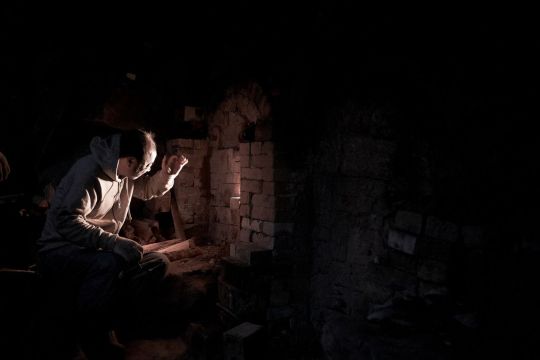
There’s a great deal of preparation that goes into making a moon jar traditionally. It’s labor-intensive: washing, sifting impurities from the clay, kneading and rolling it to remove air bubbles, carrying around these large hunks, not to mention hand throwing the clay itself to that oversized bowl shape without collapsing, and the work keeping a pine wood fire burning for 24 hours while the pot hardens in the kiln. Kwon also built his own kiln to replicate the old process as closely as possible.
“I do this because it’s fun,” he said in a phone interview. “Every time I make something, it’s novel … The quality of the material is different every time. The conditions in which I make the pots is new every time.”
Kwon said he also feels an emotional connection to the moon jar. As a student he was so moved by a one he saw in a Korean antique store that he decided they would be his life’s work. “They feel alive,” he said.
In a 2019 book on his work by Axel Vervoodt Gallery the potter is quoted saying he tries to produce art that needs no addition or subtraction. “I wish to create work that has an imposing presence but harmonizes with its surroundings regardless of where and when it is displayed. It should give peace of mind and a sense of comfort to all who look at it.”
By Christy Choi.
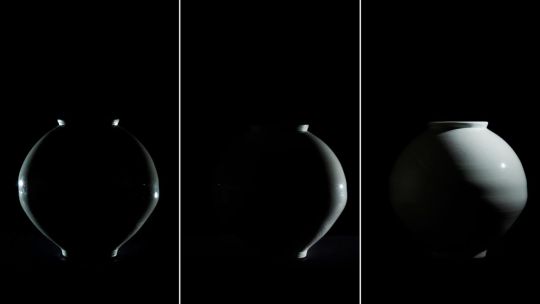
#Moon Jars#Why These Imperfect Korean ‘Moon Jars’ Sell for Millions#Dalhangari#Joseon dynasty#pottery#porcelain#Bernard Leach#Lucie Rie#Kwon Dae Sup#ancient artifacts#archeology#archeolgst#history#history news#ancient history#ancient culture#ancient civilizations#korean history#korean art#art#artist#art work#art world#art news#long reads
129 notes
·
View notes
Text

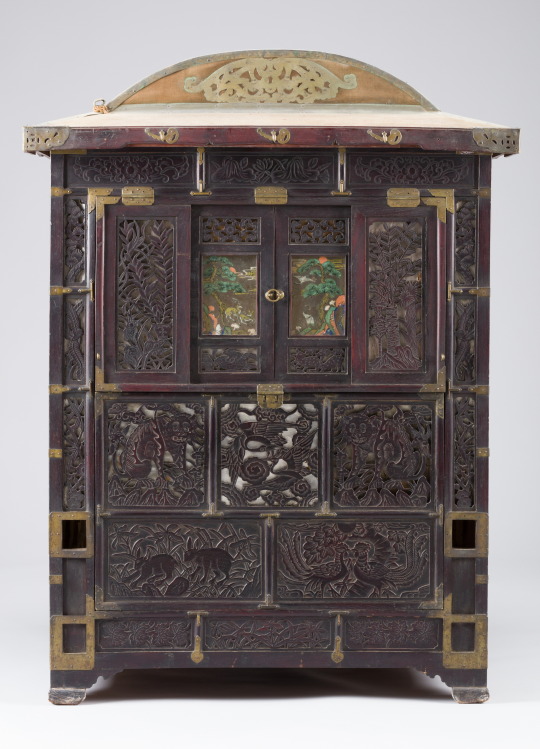
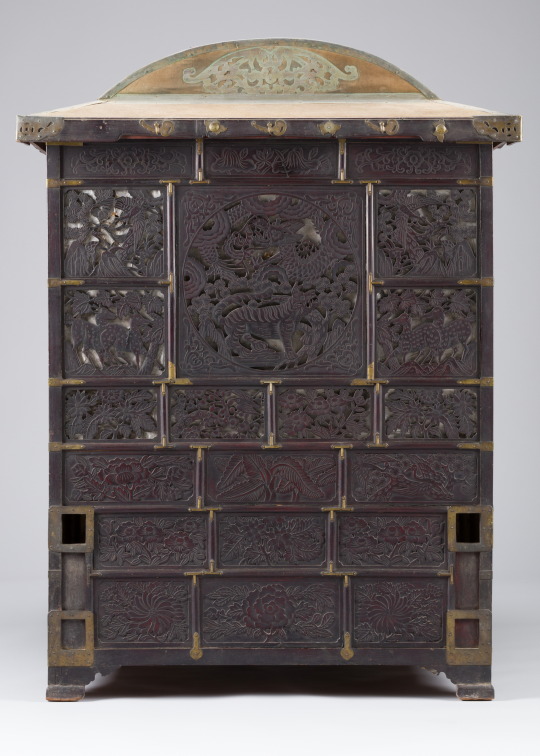
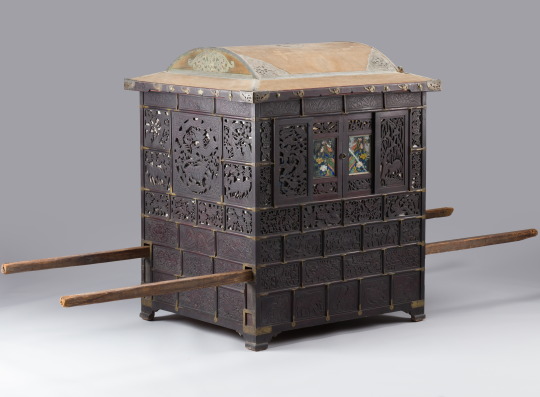
"Sain-Gyo," Wedding Palanquin.
Height:102
Height:77.5
Width:91
Collection National Folk Museum of Korea, Seoul.
15 notes
·
View notes
Text
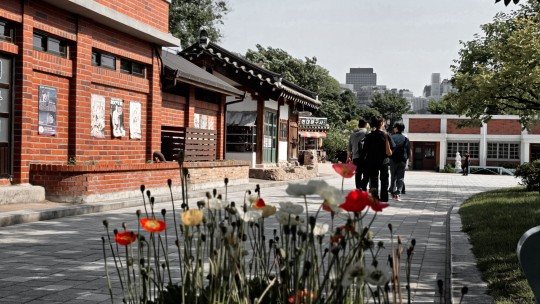

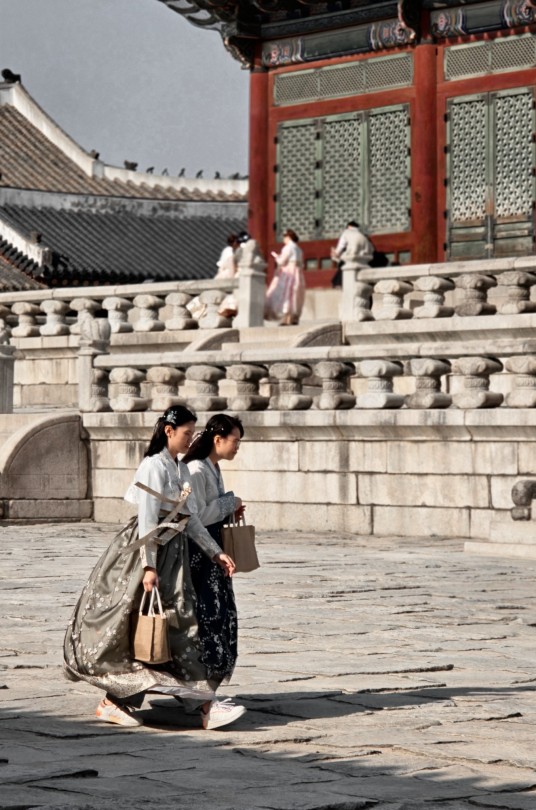
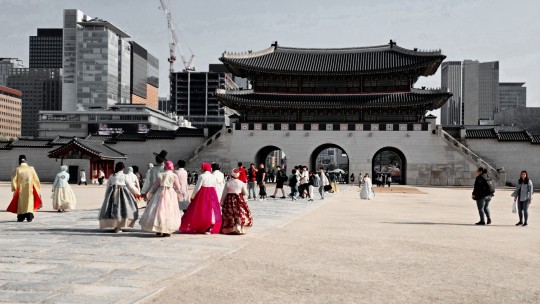
Who are we? Walking around Gyeongbokgung Palace...
After finishing today's lecture schedule
I'm on the road.
It's already been 4 years
Since I've been going back and forth on this road several times a year
Now I'm very used to the snow.
Let's forget about the Bukchon Hanok Village course
along the Samcheong-dong road
To the National Folk Museum of Korea and Gyeongbokgung Palace
I've got my way.
https://m.blog.naver.com/sdkimm/223443150531
2 notes
·
View notes
Text

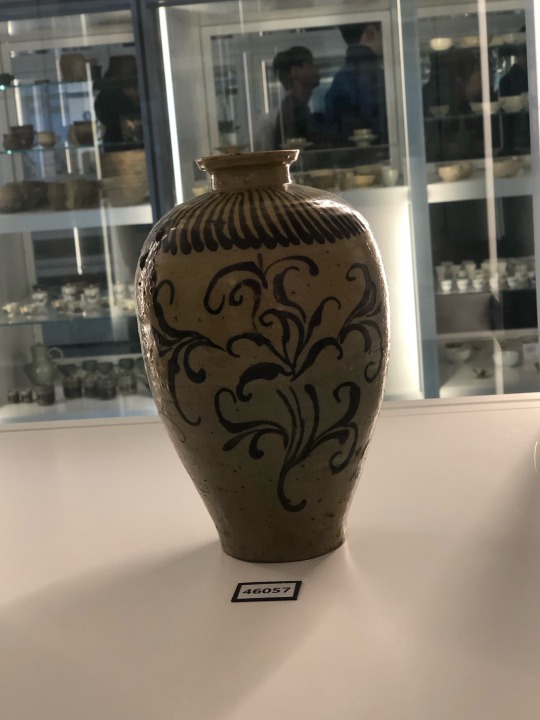
2 favs from the national folk museum of south korea
3 notes
·
View notes
Text




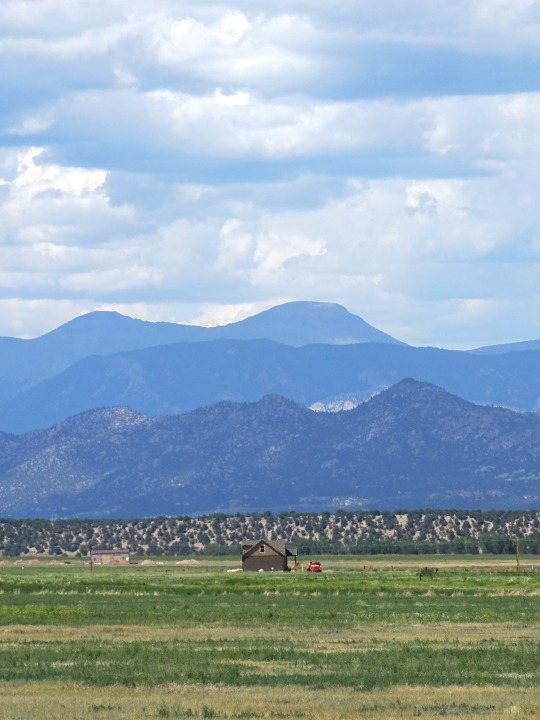






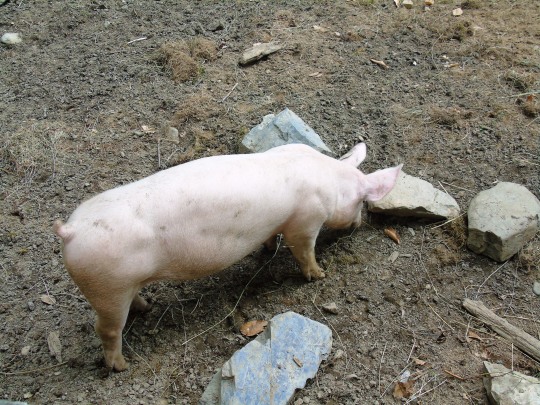
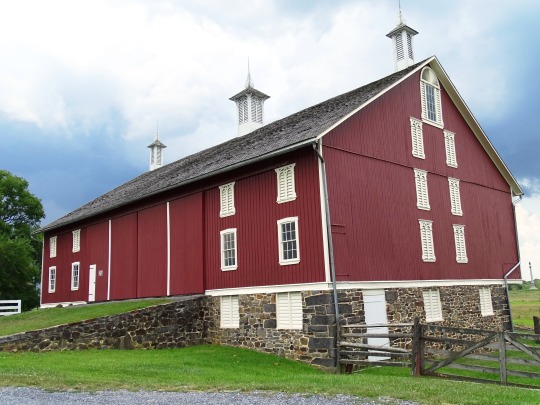


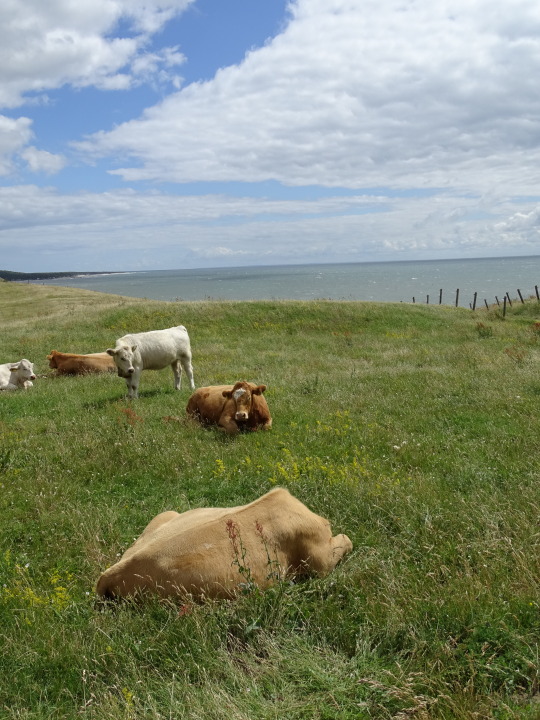



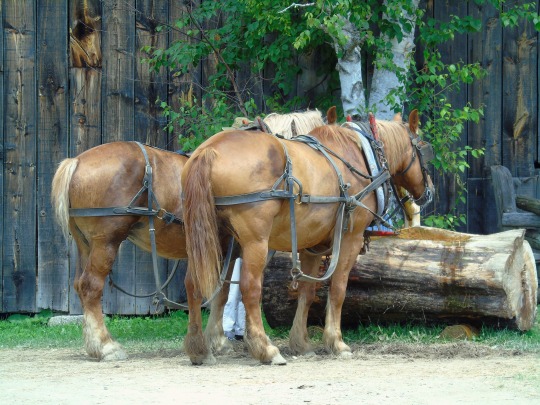


National Farmers Day
Without farmers, we’d all starve. Visit a farmer’s market, take a trip to a farm, or reenact how farmers used to live and grow with old-fashioned tools.
Some might say that modern society was built upon the rugged shoulders and stubborn personalities of farmers from around the world. Because without those who dedicate their lives to growing food, where would everyone else be?
So, it only makes sense that a time should be set aside to celebrate their contributions and all that they have provided (and indeed continue to provide) to the world. National Farmers Day intends to do just this!
History of National Farmers Day
Due to the fact that farmers have been honored for centuries, the roots of this day are likely to go back very far and with a wide variety of traditions! Many different countries have set aside dates for celebrating National Farmers Day at different times of the year. For instance, in India and Pakistan a day for farmers is celebrated in December, while South Korea celebrates in November and Zambia in October.
In the United States, some people have celebrated a time in late October as “Old Farmer’s Day”, with a festival located in Loranger, Louisiana that reenacts the farmers’ way of life from before technology changed it so much. Other communities may host their own events and activities that offer a nod to the important work that farmers do to put food on the table of families everywhere.
National Farmers Day offers a delightful time in the harvest season of the autumn to show some appreciation and love for those folks who toil and work to provide food for those in the communities around them. Whether celebrating small micro farmers who grow or local organic dairy farmers, this is an ideal opportunity to make a big deal out of something so important as farmers!
How to Celebrate National Farmers Day
Celebrating National Farmers Day can take on a few different forms but may partially depend on where a person lives. Have some fun making plans and celebrating these salt of the earth folks with some of these ideas:
Thank a Farmer
One of the best ways to celebrate National Farmers Day would be to begin by thanking a farmer! For those who live in a rural community, this might just mean visiting a friend who is a farmer and wishing them a happy National Farmers Day! Or, head on over to a local farmers market in the area and let the growers there know how much their hard work and effort is appreciated on this important day.
Visit a Working Farm
Those who live in or near the country might want to observe National Farmers Day by participating in activities that reenact the ancient methods of farming before the invention of electricity and modern equipment. Throughout the US, many different communities can be found that allow visitors to get a glance into the past, including places like:
Conner Prairie Farm in Fishers, Indiana
Living History Farm in Urbandale, Iowa
Oliver Kelley Farm in Elk River, Minnesota
Howard County Living Farm Heritage Museum in West Friendship, Maryland
Join in on Farming Events and Activities
Many times, a state fair is a place where farmers will join together to show off their produce or animals. There may even be some local festivals to attend that are centered around local produce like a pumpkin festival, a corn festival or an apple festival. These types of gatherings are often places where a variety of types of local farmers can be found.
City dwellers can choose to celebrate National Farmers Day by taking a trip to a rural area and visiting a local farmers’ market. There is no doubt that the fruits and vegetables encountered alone should make up for the drive!
Learn Interesting Facts About Farming
National Farmers Day is a perfect time to brush up on some facts and statistics related to the appreciation of farming. Check out some of these:
Around 97% of farms in the US are family owned and operated.
In 2019, more than 22 million US jobs were related to agriculture and food.
Only 2% of the American population are the farmers who feed everyone else!
Source
#National Farmers Day#sheep#Tyresta National Park#Sweden#Spain#goat#pig#Canada#Kings Landing Historical Settlement#horse#Braunvieh#cow#cattle#LUGA#Lucerne#Switzerland#farm building#Gettysburg Battlefield Historic District#architecture#landscape#countryside#flora#fauna#animal#travel#summer vacation#original photography#National Farmers Day#12 October#NationalFarmersDay
5 notes
·
View notes
Text

“Ssireum (Korean wrestling)” (Joseon, 18th century) by Kim Hong-do, also known as Danwon (1745–1806), National Museum of Korea.
Ssireum (Hangul 씨름), or Korean wrestling, is a folk wrestling style and traditional national sport of Korea that began in the fourth century.
The earliest evidence of ssireum dates back to the Goguryeo period. Originally used in military applications, ssireum became a popular pastime of the people, including many Korean kings, during the Goryeo and Joseon periods.
In traditional life, ssireum was a popular activity on the Korean holiday of Dano, the fifth day of the fifth lunar month, and tournaments are held in the summer and autumn. The traditional prize at a tournament was an ox, a valuable commodity in an agriculturally based society and symbolizing the strength of the contestant. [Wikipedia]
Digital Download on Pittoresko
Visit our Collection of Traditional Korean Art Prints
#korean painting#south korean art#korean history#south korea#korean#ssireum#korean wrestling#korean aesthetic#korea#historical painting#historical art#oriental art#joseon era#joseon dynasty#joseon#genre painting#asian art
8 notes
·
View notes
Video
youtube
South Korea Tourism
To arrange a good and memorable trip to South Korea, it is advised to read travel guides about this beautiful country, and then contact a local travel professional who may help you organize this tour in the most effective way for reasonable money.
South Korea has a lot of natural places to be observed and historical landmarks to enjoy. The country plays an important role in the protection of the heritage of world culture and natural attractions. Apart from that, it is considered a hospitable place for foreigners and a perspective tourism destination.
In the south-east of the country, one will find Bulguksa monastery and the Seokguram cave temple adjacent to it. Another noteworthy place is Temple Jongmyo, located in Seoul, where memorial tablets of the monarchs of the Joseon Dynasty are stored.
Seorak Mountain is a part of the Diamond Mountains, which is considered one of the most beautiful places in the world. Hallasan mountain is the extinct volcano. Both picturesque places are loved by numerous international visitors. The city of Gyeongju is known for its Tumuli Park, Onyn Five Tombs, Chhomsonde Observatory, the tomb of General Kim Yu Sin, and Mount Namsan with the ruins of pagodas and monasteries. Gyeongju National Museum and the resort on Lake Pomun offer wonderful recreational opportunities.
Ganghwa Island in Korea is known for its historical monuments and beautiful nature. Among the main attractions of the island one should name an altar built by Tangun, the legendary founder of the nation, the fortress walls, the ancient furnace for the production of celadon built in the 13th century, and Chondynsa monastery. The beaches of the eastern coast of Korea are known for weak currents and are considered the best in Korea.
Korea will surely capture your imagination with plenty of Buddhist monasteries and temples, palaces, exquisite statues, which have ancient and rich history. Seoul is perhaps the main place for tourists, with its National Museum, the Institute of Korean classical music named Sejong Cultural Center, Hoam Center for the Arts, Namsan Tower, and Korea House. In the capital of Korea one can visit Gyeongbokgung Palace, known as The Palace of Radiant Happiness, and one of the five palaces in Seoul. The main palace was built by the founder of Joseon dynasty, King Lee Sung-Te, when the state capital was transferred to Seoul. On the palace grounds, there is the National Folk Museum with a rich exposition, which introduces you to the history, culture and traditions of Korea.
No less interesting is Changdeokgung Palace in Seoul, which consists of the king's residence and Secret Garden. Built in 1405, it is the only palace that has preserved the architectural style of the Joseon Dynasty. Secret Garden is a place for entertainment of the ruling dynasty: the nature has harmoniously created its 300-year-old trees, the pond and the pavilion.
2 notes
·
View notes
Video
youtube
What Are South Korea's Famous Tourist Attractions and Activities?
Gyeongju
Korea's ancient capital, Gyeongju, is the country's big must-see, and rates as one of the ten most important ancient cultural cities in the world. In among the shops and markets in the modern-day city you'll find abundant relics of its two-thousand-year history, including colossal fifth-century tombs and burial mounds, a seventh-century stone observatory, and the royal pleasure gardens of Anapji, which were designed in 674 AD. Other quarters of Gyeongju are rich with elegant pagodas and historic wooden Buddhist temples, and numerous trails take you to the slopes of the sacred mountain, Nam-san, which dominates the south of the city.
Hiking in the national parks
South Korea is full of exhilarating national parks, all of which are crisscrossed by clearly marked trails and dotted with good camping spots (and the occasional mountain hut). The cream of the crop is Seorak-san, and in particular Naeseorak (Inner Seorak), an exceptionally tranquil stretch of forested peaks, rivers, waterfalls and Buddhist temples - and some established rock climbs too. Also well worth seeking out are Jiri-san, which boasts a 65-kilometre-long ridge trail and lots of historic temples; the popular and fairly gentle trails of Songni-san; and Bukhansan, which is on the edge of Seoul.
Seoul
South Korea's modern day capital has a reasonable number of sights to keep you entertained for a few days. Most interesting are the five imposing royal palaces, some of which date back to the fifteenth century. Inside the Changdokkung Palace you'll find one of South Korea's loveliest gardens, the Piwon, a beautifully landscaped haven of ponds and pavilions. In the modern part of town, check out the Kimchi Museum, dedicated to fiery pickled cabbage that is South Korea's national dish, browse the cutting-edge Leeum Museum of Modern Art, and spend the evening in the trendy nightlufe district of Sinchon.
Panmunjeom
On the 38th parallel, the 1953 ceasefire line between North and South Korea - a four-kilometre-wide strip of land spiked with guardposts - is still in force today, and the village of Panmunjeom, which stands on the DMZ just 56km north of Seoul, is a popular day-trip from the capital. Unless you can afford the cost of joining an organized tour around North Korea, this is the closest you can get to the repressive, desperately impoverished totalitarian state. There's no border crossing here (or anywhere between the two countries) but Panmunjeom attracts busloads of tourists, all of whom required to dress smartly (No jeans, T-shirts or miniskirts) and, if male, to have a respectable haircut!
The Korean Folk Village
It may sound like a coach tour nightmare, but the Korean Folk Village is well worth a day-trip from Seoul, especially if you've not got time to explore the rest of the country. A reconstruction of a typical nineteenth-century village, it's complete with Buddhist temple, Confucian school, pottery and weaving workshops, blacksmiths and traditional farmhouses. The people you see in the village do actually live and work there, even if they might look like actors dolled up in traditional outfits.
Jeju-do
This southern island has maintained traditions that have long disappeared from the mainland and is now a popular tourist destination as well as a favorite with local honeymooners. Highlights here include mysterious Easter Island-like statues, hikes to the summit of Halla-san (South Korea's highest volcano), and a seven-kilometer-long lava-tube cave. The climate down here is warmer and wetter that in the rest of the country, but don't come specifically foe the beaches, as you'll find them crowded and disappointingly scruffy
3 notes
·
View notes
Video
youtube
Places To See in Seoul - South Korea
There's nothing better than planning a vacation, especially one that you're really excited about. You purchase your tickets, pack your packs, and afterward the best part: you start to wander off in daydream about your Trip as you plan your itinerary, making a rundown of the spots you must see while you're far from home. As the lists gets longer, your Excitement grows, and before you know it's a great time to go Seoul!!
With such a significant number of spots to visit, arranging a trip to Korea can be overwhelming. We have created a list of the top most Amazing attractions in seoul, South Korea as of 2018. These attractions are perfect for adding to your tour schedule!
1. N Seoul Tower
No outing to Seoul is finished without a trip to the famous N Seoul Tower. N Seoul Tower was the first of its kind - no other pinnacle like vacation destination had been built in Korea prior to its construction. The tower sits at 236 meters tall, which implies that while you're at the best, you're at the second most elevated point in the whole city.
While you're visiting the Tower, there are an assortment of activities that will keep you occupied, so make sure you clear several hours for the trip. You'll at first need to look at the perception decks, which give you a magnificent panoramic view of Seoul that makes for totally culminate photographs. While you're on the deck, you'll obviously need photographs of the city, however keep in mind to have a companion (or stranger/new friend) snap a photo of you with the city as a scenery to demonstrate to your friends back home!
2. Gyeongbokgung
If you ask the people you meet in Seoul what you absolutely must do with your time in the city, most will tell Gyeongbokgung Palace some place on their list ). This eminent royal residence was Built in 1395, so in addition to the fact that it is a standout amongst the most excellent man-made structures on the planet, it's also over 600 years old!
This royal Palace is the biggest of the Five Grand Palaces, and accordingly, it's a quintessential piece of Korean history. The Kings of the Joseon tradition lived in this royal Palace, and its design and architecture that - it is unmistakably fit for Royalty.
A little more than one hundred years back, Imperial Japan decimated the majority of the Places, which was wrecking for Korea. While it is still being restored up 'til today, it is a completely astonishing complex that will take you hours to see in its entirety. The complex is additionally home to two unique museums, The National Folk Museum and The National Palace Museum of Korea.
3. Submerged Tomb of King Munmu
Once you've gotten your fill of the city, Visit to the sea to look at the Underwater Tomb of King Munmu, a must-see tourist attraction in Korea. King Munmu was a ruler that lived right around 1,500 years back, and he is essential to Korean history because he unified three unique kingdoms, merging their power into one.
Why is he buried underwater, you ask? Trust it or not, he wanted it that way! King Munmu believed that if he were buried covered in the ocean after his demise, he would return as a dragon to protect the land he helped lead towards greatness.
Reasons Why You Should Visit South Korea
1. All year celebrations
Consistently, there are a greater number of celebrations in South Korea than one could Attend, a couple of main festivities everybody likes to participate in. At the point when the snow melts and the climate gets hotter, pink and white cherry blooms change South Korea into a magical wonderland for a small period towards the start of spring, and a large number of individuals come to see the blooms from everywhere throughout the nation. Buddha's Birthday is another Major occasion celebrated in May with lantern parades and performances at nearby temples, while in fall, Koreans commend their own Version of Thanksgiving amid Chuseok and respect their ancestors during proudly conducted ceremonies. Actually, there are celebrations in each month of the year for every taste.
2. Rich history
South Korea has a long history going back finished a thousand years. Because of the natural isolation of the Korean Peninsula, the nation's way of life hasn't changed as much as in different regions. Still today, you can remain in wonder of the absolute significant cultural heritage sites of the nation, for example, Gyeongbokgung Palace, the main palace situated in Seoul. The city of Gyeongju is likewise a place of historic value and is regularly called a 'museum without walls'. Gyeongju was the capital of Korea during the Silla Dynasty from 57 BC - 935 AD and is home to countless royal tombs, royal palaces, and temples that are listed as UNESCO World Heritage sites.
3. Throbbing society
Because of their long history, South Koreans have an assortment of customs they have kept alive throughout centuries. 'still today individuals love to dress in in traditional clothes (hanbok) - you can lease it to wear around Seoul and Jeonju', for instance. In Modern Seoul, you can still find traditional hanok house neighborhoods with lovely teahouses that have been in existence for decades. This blend of old and new is really Fun to Explore when traveling in South Korea.
4 notes
·
View notes
Text
The 5 Royal Palaces In South Korea
1. Gyeongbokgung
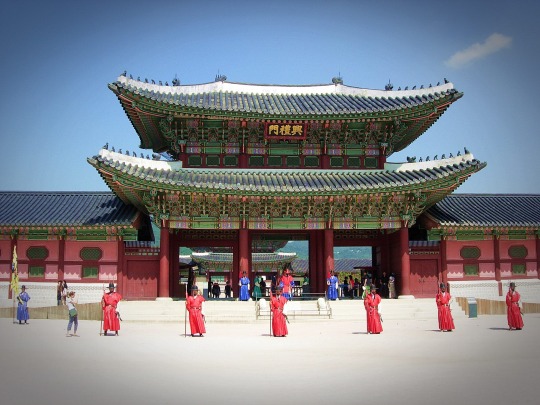
Gyeongbokgung consists of a throne hall, monarch’s residence, gardens, and pavilions. It is the biggest and most stunning palaces out of all the Joseon palaces. It emphasizes the palace’s auspicious and affluent nature with colors of ruby and jade where the National Palace Museum of Korea, National Museum of Korea, and the National Folk Museum are on these grounds.
2. Changdeokgung
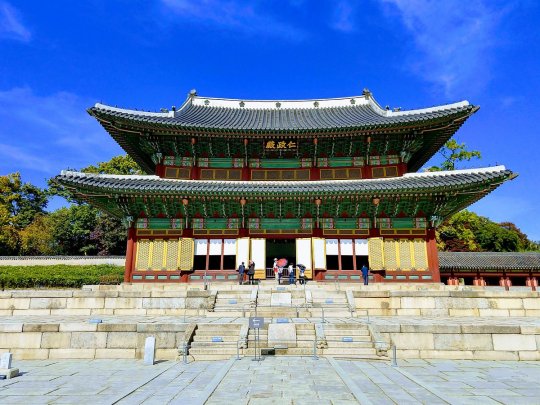
Many Joseon dynasty kings had their main residences here. It is a UNESCO World Heritage Site. The palace was built according to pungsu with the topography in mind. The palace’s main building faces south, while the hidden garden faces north. The buildings in the complex were arranged according to Confucian principles both practically and symbolically.
3. Changgyeonggung

It was originally built by King Sejeong for his farther King Taejong. It was formerly known as Suganggung and was connected to Chandeokgung. This palace is quite small compared to the other royal palaces. This palace was often served as the residential quarters for queens and concubines. It also has a Grand Greenhouse inside.
4. Deoksugung
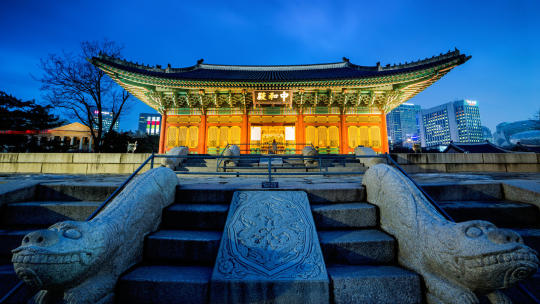
Deoksugang wasn’t classified as a royal palace at first. It was initially a residential home of Grand Prince Wolsan. However, the royal family’s home was burned down during the Imjin War. So they had to relocate to this area. It is famous for its elegant stone-wall road and integration of European architecture within complex.
5. Gyeonghuigung
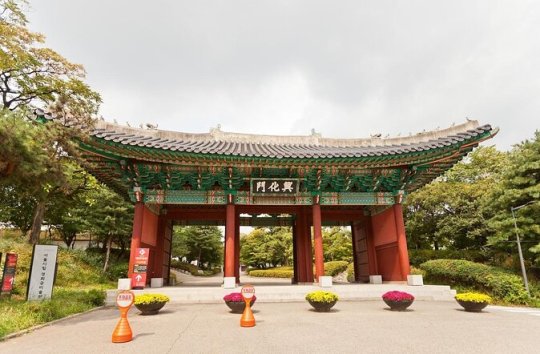
It is the youngest palace among all and was known as the King’s emergency palace. It is not as famous as the other palaces, but is still ideal to visit as you can appreciate the authentic Korean architecture too. On the palace grounds, you can find the Seoul Museum of History and the Gyeonghuigung Annex Building of the Seoul Museum of Art.
#korean palace#korean royal palace#royal palace#palaces#korea palaces#korean palaces#korean history#Korean Joseon Dynasty#korea joseon dynasty#king sejeong#korea facts#korea guide#south korea guide#south korea headers#korea headers#Korea Republic#korea tour#korea tips#korea places#korea vlog#korea blog#korea#korean architecture#korean facts#korean guide#korean headers#korean lesson#korean resources#korean tour#korean places
12 notes
·
View notes
Photo


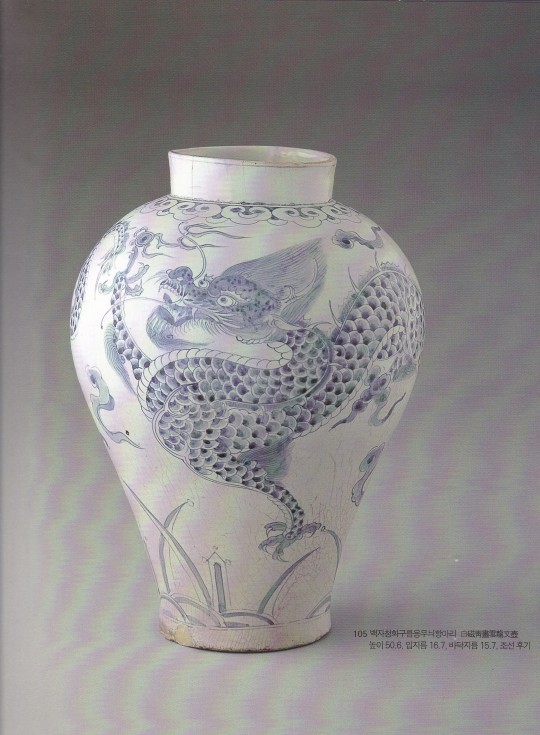
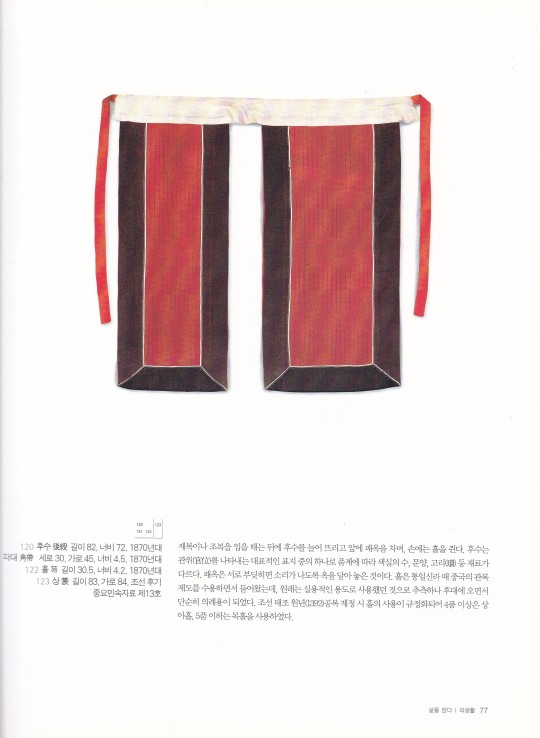
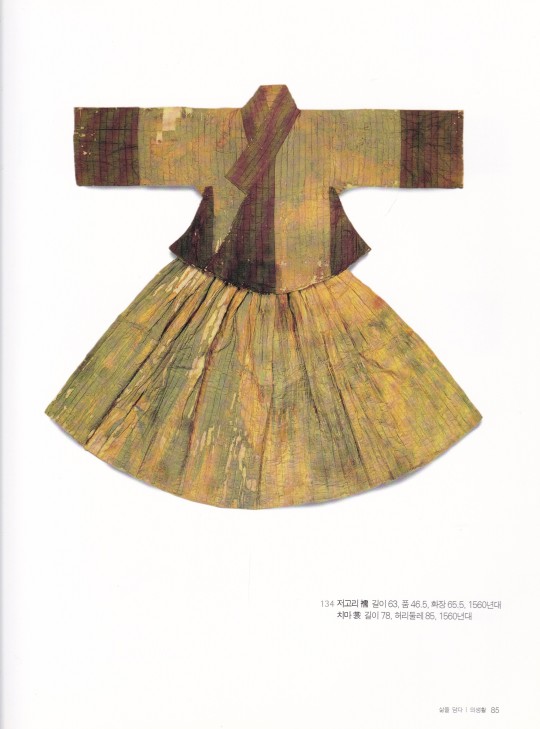
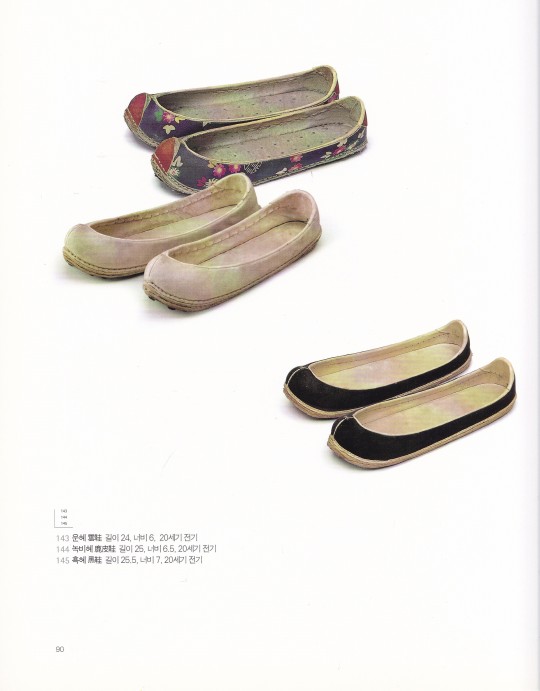
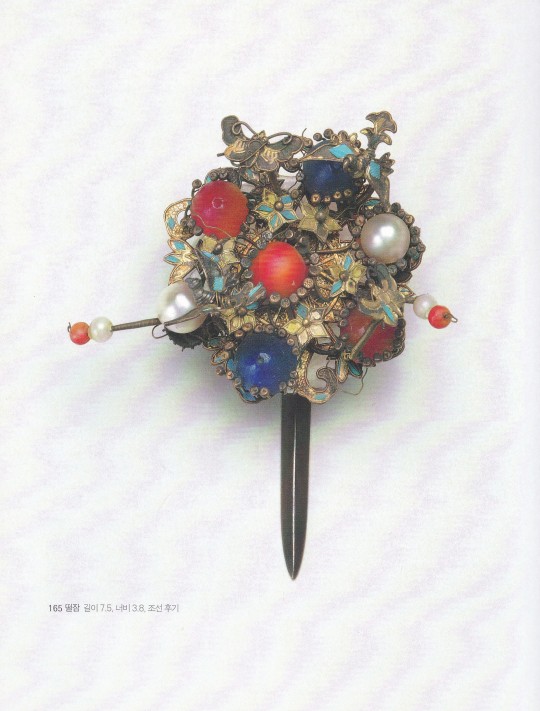

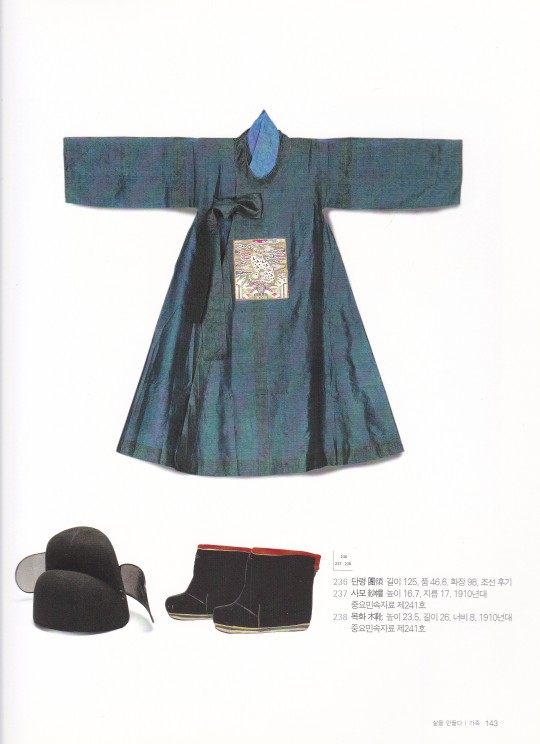
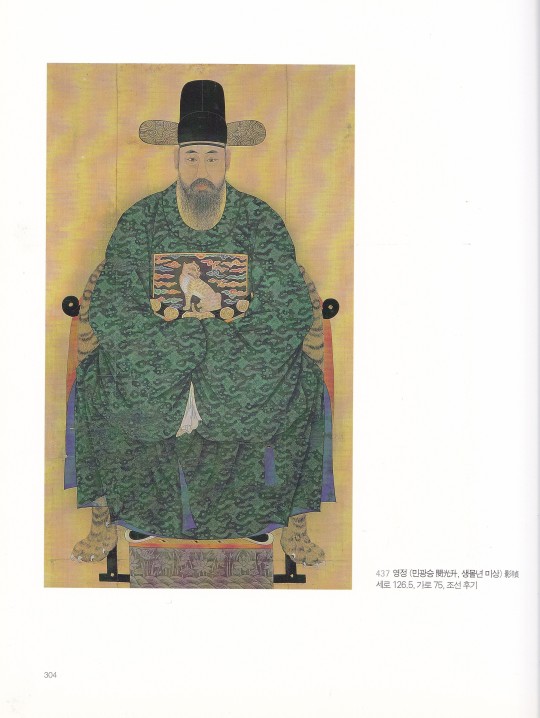
The Collection of the National Folk Museum of Korea
GNA Communication, Seoul 2006, 328 pages, 23,1 x 28,8 cm, ISBN 978-89-950808-3-2
euro 90,00
email if you want to buy [email protected]
A prospect on the Korean Lifestyle
Themed by the life stories of Koreans, the catalogue closely reflects the life passage of Korean from the birth to the death. This publication is also a result of the museums' collecting activity for last 14 years after the re-location to the current museum building in 1993.
The Story of our lives in Catalogue
In the catalogue, total of 638 representing items including several national designated cultural properties were selected to show the daily life of Korean among 85,000 collections. Consisted of 5 main chapters, ‘Sustaining Life’ - ‘Supporting Life’ - ‘Forming Life’ - ‘Enjoying Life’ - ‘Ending Life’, the composition of catalogue encompasses the themes as follows; Life, Housing, Clothing, Food, Agriculture, Commerce, Family, Education, Success, Religion, Entertainment, Hobbies, Handicrafts, Funeral, Ancestral Rites, etc. Representing images and brief outline are given to focus on the importance and the meaning of each object and outlines are written by the specialists of the NFMK together with the museum's collecting activities.
01/05/23
orders to: [email protected]
ordini a: [email protected]
twitter: fashionbooksmilano
instagram: fashionbooksmilano, designbooksmilano tumblr: fashionbooksmilano, designbooksmilano
#National Kolk Museum Korea#Korea#clothing#handicrafts#footwear#jewelry#clothes#ceramics#designbooksmilano#fashionbooksmilano
6 notes
·
View notes
Text
This painting by Jang Seung-eop (1843-1897) shows a pine tree, eagle, and rabbit. Chueungtobakdo, a painting in which a hawk gazes at a rabbit, is a leading image used to celebrate a new year during Korea's Joseon era.
I reckon, this painting is a perfect symbolism of new year 2023, a Year of the Rabbit 兔 in Chinese & East Asian zodiac and socio-politica-business esoterica. As for me, I have no doubt that next year would be a year of glocal polycrisis: socio-political-economic-business-climate crisis.
And individuals, organizations, companies, and nations need to have the "agility and wisdom" of a rabbit to survive and thrive against the intimidating presence and predatory blackswan-like rapaciousness of a hawk.
Photo: National Folk Museum of Korea
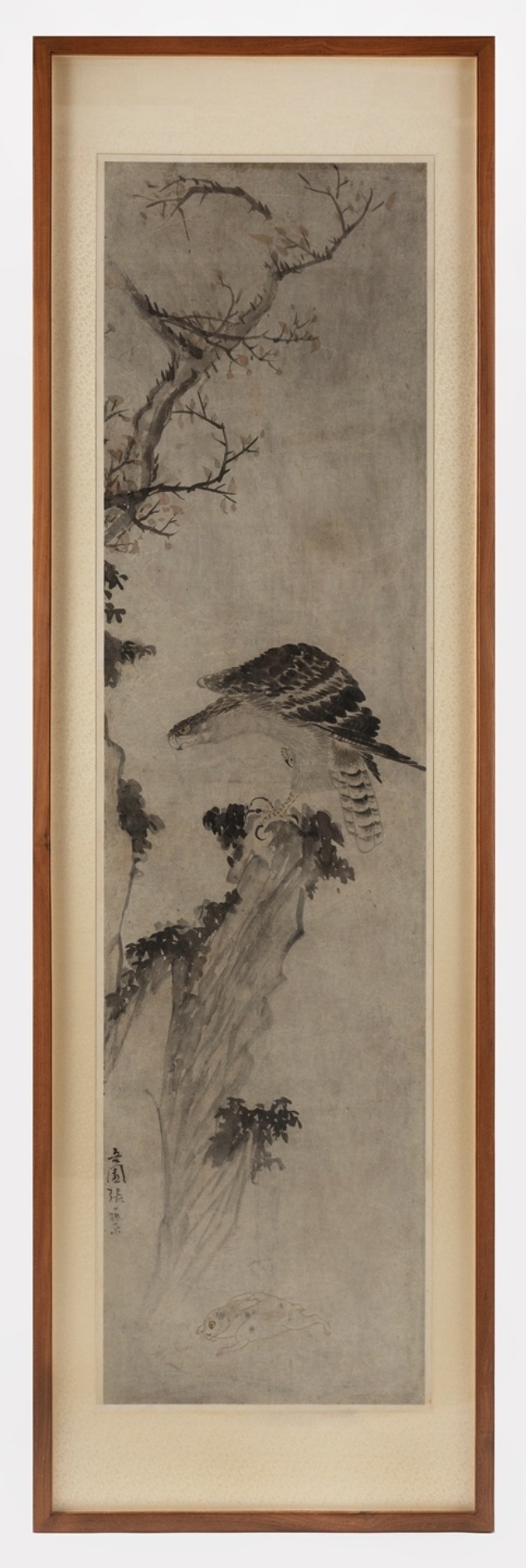
Photo: National Folk Museum of Korea
3 notes
·
View notes
